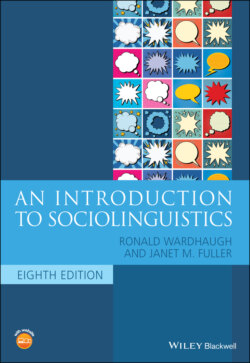Читать книгу An Introduction to Sociolinguistics - Ronald Wardhaugh, Janet M. Fuller - Страница 22
Language Users and Their Groups: Identities
ОглавлениеIn order to talk about how people use language, we must talk about both individuals and groups, together with the relationships between people within and across groups. One of the current ways of thinking about this focuses on language user identities. The term identity has been used in a variety of ways in both the social sciences and lay speech. In current social theory, identities are not seen as fixed attributes of people or groups but are dynamically constructed aspects which emerge through social behavior, including but not limited to language use. Although we do look at identities of individuals, what we are primarily concerned with is social identity: ‘Identity is defined as the linguistic construction of membership in one or more social groups or categories’ (Kroskrity 2000, 111).
In such a view, identities are not preconceived categorical affiliations such as ‘male’ or ‘female’ but nuanced ways of being that we construct; while we may indeed reference such categories, our identities are not simply a matter of listing demographic identifiers (e.g., ‘single white female, 45, architect, nature lover’). So while a speaker may introduce a comment by saying As a mother …, thus explicitly referencing this aspect of her identity, what will emerge is a more nuanced picture of what type of mother she is – for example, protective, feminist, one who encourages independence, one who is concerned with the upward mobility of her children. Named social categories such as ‘single mother’ or ‘helicopter parent’ are not our identities but concepts we use to construct our identities.
Further, our identities are fluid and we do not have a single identity but multiple levels of identity, and shifting and sometimes even conflicting identities which emerge in different contexts. To continue the example above, the speaker may reference her identity as a mother but then also focus on how she identifies strongly with her profession and struggles to balance this with the demands of parenthood; this may be intertwined with her gender identity and her social class identity. In another conversation, this same person might use particular lexical items to focus on her regional affiliation to construct a different aspect of her identity, and to align herself with an interlocutor who shares this background. Thus, the identities we construct are constantly shifting, and also at different levels, from macro‐categories such as ‘woman’ or ‘southerner’ to interactional positionings such as alignment.
Likewise, group identity categories are constantly being negotiated. What it means to be the member of a particular social category (e.g., ‘gay,’ ‘educated,’ ‘Latinx’) may vary over time, space, and situation, and how particular language users identify with or are assigned to these categories may also vary. We will revisit this concept of multiple identities throughout this text because it is highly relevant to our study of language in society.
So far, we have said that the term ‘society’ refers to a group of people unified through some purpose; other concepts such as ‘speech community,’ ‘social network,’ and ‘community of practice’ will be found in the pages that follow (see especially sections devoted to these concepts in chapter 3). We will see how these are useful if we wish to refer to groups of various kinds, since it is among groups that individuals form relationships or reject connections with others. The groups can be long‐lasting or temporary, large or small, close‐knit or casual, and formally or informally organized. This is, therefore, another level of complexity we must acknowledge in the pages that follow as we refer to ‘middle class,’ ‘women,’ ‘speakers of Haitian Creole,’ ‘teenagers,’ and so on. We must remember that these categorizations also have a process side to them: all must be enacted, performed, or reproduced in order to exist. Socioeconomic class, gender, language background, and age are only important aspects of our identities and groups if we choose to organize our lives in that way; in some contexts they may not be salient social categories and we may instead see ourselves as members of groups based on racial identification, sexual orientation, national belonging, or membership of a particular formal social group (e.g., a choir, a professional association, or a fox hunting club).
Bucholtz and Hall (2005) provide a framework for the analysis of the linguistic construction of social identities. Central to this framework are the ideas of identity as emergent in interaction and encompassing different aspects of identity, simultaneously but also varying across interactions. In chapters 7 and 8, in our discussions of interactional sociolinguistics and multilingual discourse, we will return to this framework to discuss the linguistic means through which identities are constructed. In this introduction to the study of identities, the main point we wish to stress is the concept of identities as relational, which is inherent in group membership. Bucholtz and Hall note that the construction of identities is not done in a vacuum, but has to do with the relationships between self and other. Similarity and difference are thus central to the process of identity construction. For example, two people may construct themselves as similar in their identities as cycling enthusiasts by using jargon specific to that group (see Exploration 1.3 below). However, another participant in the conversation may construct difference in identity by avoiding such jargon or using words such as ‘thingamajig’ or ‘whatchamacallit’ to refer to bike parts. Another aspect of identity which has been the focus of sociolinguistic studies is authenticity (e.g., Jones 2011; Mason Carris 2011; Shenk 2008; Westinen 2014). These studies show that language is used to construct authenticity not just in linguistic groups but also in ethnic categories, sexuality groups, or in groups related to expertise and activity, such as hip‐hop artists. Thus, the construction of the social identities is inherently also about the construction of social groups in terms of boundaries and membership.
